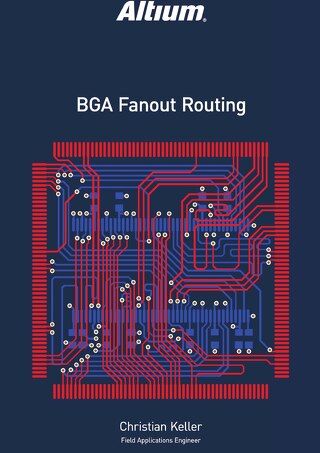The Challenge of Grounding

Altium Designer provides you with the variety of methods you need to solve all different grounding challenges in all different design types.
INTRODUCTION
Grounding has proven to be one of the greatest challenges in modern Printed Circuit Board PCB grounding design. Circuits continue to become more complex over time, as new technologies make them smaller, and we continue to make the transition from analog to digital. And these smaller, more intelligent, more connected devices are providing a variety of increasing challenges when it comes to grounding their circuits properly. And that challenge doesn’t promise to get any easier in the foreseeable future.Unfortunately, there’s no guidebook wherein we can look up how to solve the myriad of challenges we may face in grounding. If there was, we could simply keep it handy during the design process and not worry. However, instead, we have to go through a host of tiny, seemingly insignificant tasks in the grounding process, with the knowledge that any misstep can cause the design to fail and need to be redesigned. As a result, you end up over budget and behind schedule, as your Time to Market increases, and your competitors have more of an opportunity to release their version of the product before you release yours. All of this and a host of other issues can result from grounding challenges. So how do you face those challenges and eliminate errors? Let’s take a look.
DIGITAL AND ANALOG WORLDS HAVE ALREADYMERGED
We mentioned the “transition” earlier from analog to digital, but that’s actually something of a misnomer. In fact, the analog and digital worlds are merging together, making grounding an issue for both types of designs, sometimes simultaneously.
METHODS FOR A PROPER GROUNDING
So what does this mean for your design process? It means you need to take control of signal return voltages and be on the lookout for spurious ground signals that can lower performance. These can occur due to common currents, signal coupling (both internal and external), etc. With the right techniques, you can minimize that noise and rid yourself of most parasitic voltages.
This leads us directly into our discussion of a mixed-signal, analog/digital environment. Mixed signal ICs are a perfect example, having both digital and analog ports, which add extra challenges to the grounding. To make things even more challenging, some mixed signal ICs have relatively low digital currents, while others have significantly higher ones. Therefore, these two types have very different needs in terms of optimal grounding, and must be treated differently.
Additionally, what works in one frequency range does not always work in another. The key is to recognize how the current flows.To get a clearer picture of the topic, let’s talk a little bit now about some of the general philosophies that exist when it comes togrounding methods in mixed-signal devices. There are several different methods that are commonly used.
1) Star Ground:
The star ground theory refers all signals to one single ground point. The key element is the single “star” point, from whichall respective voltages are measured. Focusing on a single point leaves no undefined ground which would otherwise cause incorrect values for your measurement. Unfortunately,while this method works well on paper, it can often be a bit difficult to put into practice in a real world scenario.

Star Grounding Topology
2) Using Planes for Shielding:

Layer Stack Legend
In most cases, the use of ground planes begins with a single layer in a multilayer board, or the bottom of a doubled sided Printed Circuit Board, which is made completely out of copper. Since the flooded side’s resistance is as low as possible, it makes a perfect shield, allowing the layer to be used for grounding. Because it’s also spread over the total size of the layer, it offers the lowest possible induction, as well as the best possible conduction, in terms of minimizing spurious ground different voltages.
We can also include voltage planes. They work on the same principle, flooding the complete layer and having the advantage of a very low impedance conductor. This is then dedicated to each plane per system Voltage, so that a system can have more than one plane.Again, this sounds good on paper, but it’s not always the best solution in practice. The plane itself still has a residual resistance and inductance. In some circumstances that can be enough to prevent the circuit from functioning the way that it’s expected to. Especially if we inject very high currents into a plane, it can cause a voltage drop that interferes with the function of the circuit.Another advantage of ground planes is the possibility of using impedance controlled microstrip or stripline techniques, for the use of high speed analog or digital signals.
3) Separating Analog Digital Ground:
It’s a truth universally acknowledged that digital circuits are far noisier than analog--particularly logic circuits such as TTL or CMOS. Logic circuits often only use a few hundred millivolts, which makes them almost immune to noisy surroundings.However, they also create a lot of their own noise.
Analogs, on the other hand, are much more vulnerable to outside noise, but don’t create much of their own. This means that when combining analog and digital circuits, the analogs’ performance can be easily corrupted by the digital noise, unless the two are separated.
When you further include components like RAM, fans, and other high-current devices, suddenly it’s no longer fine to run yoursystems in a noisy environment without proper shielding.
The solution is to keep your analog and digital ground joined at a single point in your system, and refer all signals to a common potential, similar to the star point systembut while maintaining proper shielding. The single point needs to be chosen wisely for the location can have a lot influence over the complete circuit. In most cases, locating it near the power supply will give you the best results. Therefore, an analysis of the flowing current is often useful, to provide a better overview of the design.

Noisy Signal
LET’S SUM IT UP
So of all the methods we’ve discussed, none of them offers a 100% effective solution for every design. So what can you do? Consider your options carefully for each design and determine which solution will work best, based on the design characteristics. Especially when working with mixed signal devices, it’s essential to have a system on hand, which can support whatever technology you need to use, and help you in implementing a proper grounding that offers the proper control mechanisms, based on your given design environment.
HOW WE CAN HELP YOU
We’ve seen that there are multiple methods in place for how grounding can be accomplished, as well as the importance of controlling analysis methods. The problem is addressing all of these issues in one tool. However, Altium Designer offers exactly that..
Using our various plugins and features, such as Net-Ties, we can connect several different signals in one place to create a star grounding. Planes are directly implemented in our layer stack and ready to use on the fly. The tool also offers the option to use split planes and define the connection style in a fast and easy-to-use environment. Intelligent copper, known as Polygons can be used for the easy flooding of defined areas. It also supports hatched technologies that are adjustable with a single click.
With additional technology support for various analysis features through our Plugin-system, you are always one step ahead of the problem, and ready to face any grounding challenges that may come your way.










